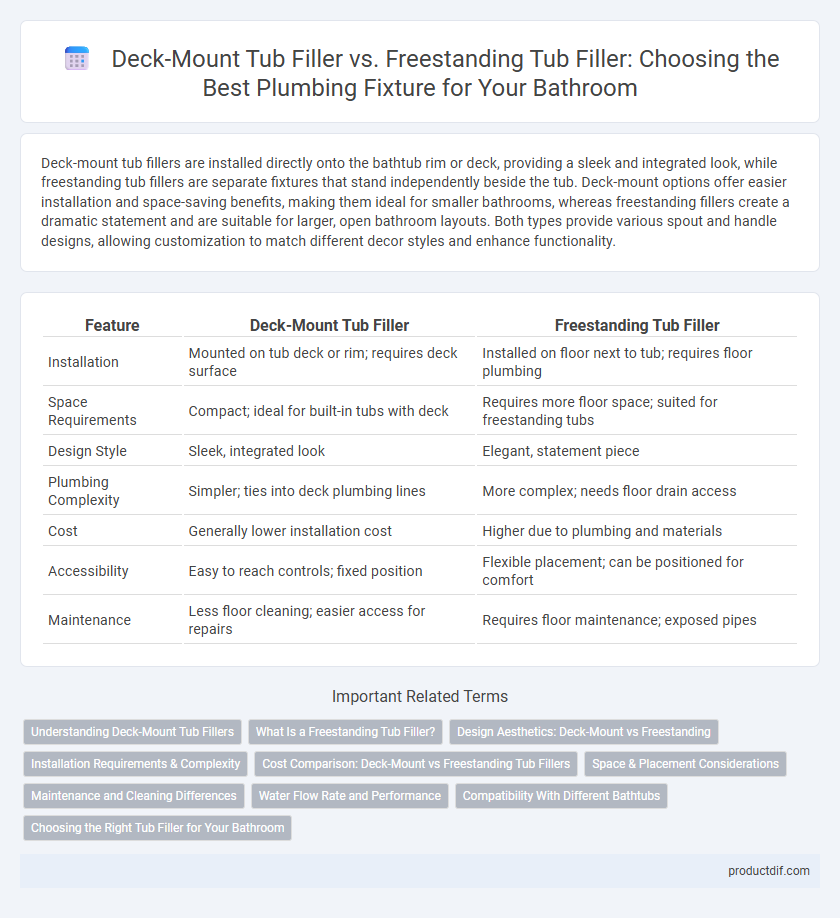Deck-mount tub fillers are installed directly onto the bathtub rim or deck, providing a sleek and integrated look, while freestanding tub fillers are separate fixtures that stand independently beside the tub. Deck-mount options offer easier installation and space-saving benefits, making them ideal for smaller bathrooms, whereas freestanding fillers create a dramatic statement and are suitable for larger, open bathroom layouts. Both types provide various spout and handle designs, allowing customization to match different decor styles and enhance functionality.
Table of Comparison
| Feature | Deck-Mount Tub Filler | Freestanding Tub Filler |
|---|---|---|
| Installation | Mounted on tub deck or rim; requires deck surface | Installed on floor next to tub; requires floor plumbing |
| Space Requirements | Compact; ideal for built-in tubs with deck | Requires more floor space; suited for freestanding tubs |
| Design Style | Sleek, integrated look | Elegant, statement piece |
| Plumbing Complexity | Simpler; ties into deck plumbing lines | More complex; needs floor drain access |
| Cost | Generally lower installation cost | Higher due to plumbing and materials |
| Accessibility | Easy to reach controls; fixed position | Flexible placement; can be positioned for comfort |
| Maintenance | Less floor cleaning; easier access for repairs | Requires floor maintenance; exposed pipes |
Understanding Deck-Mount Tub Fillers
Deck-mount tub fillers are installed directly onto the rim of the bathtub or adjacent deck, providing a streamlined and space-saving solution for water delivery. These fixtures are compatible with bathtubs that have a flat surface surrounding the tub, allowing for easy access and maintenance. Compared to freestanding tub fillers, deck-mount options offer enhanced stability and seamless integration with bathroom countertops or tub surrounds.
What Is a Freestanding Tub Filler?
A freestanding tub filler is a plumbing fixture designed to stand independently on the bathroom floor, providing a sleek and modern way to fill standalone bathtubs. Unlike deck-mount tub fillers that attach to the tub rim or platform, freestanding models offer greater design flexibility and can be placed anywhere around the tub, enhancing both aesthetics and functionality. Popular materials for freestanding tub fillers include brass and stainless steel, often featuring stylish finishes like matte black or brushed nickel for enhanced durability and visual appeal.
Design Aesthetics: Deck-Mount vs Freestanding
Deck-mount tub fillers integrate seamlessly with the bathtub rim, offering a sleek and minimalist design that complements modern and traditional bathrooms alike. Freestanding tub fillers serve as dramatic focal points, often featuring sculptural and elegant forms that enhance spacious bathroom layouts. Choosing between these fixtures depends on the desired visual impact and spatial configuration of the bathroom environment.
Installation Requirements & Complexity
Deck-mount tub fillers require precise installation on a tub deck or rim, necessitating pre-drilled holes and compatibility with the bathtub's edge thickness, which can limit placement flexibility. Freestanding tub fillers demand more complex installation involving secure floor mounting, robust plumbing connections through the floor, and potential structural reinforcement to support their weight and stability. The choice between the two hinges on existing bathroom layout constraints and the homeowner's willingness to accommodate varying installation complexities and costs.
Cost Comparison: Deck-Mount vs Freestanding Tub Fillers
Deck-mount tub fillers generally cost less due to simpler installation on existing surfaces, with prices typically ranging from $150 to $400. Freestanding tub fillers demand higher investment, often between $400 and $1,200, reflecting complex plumbing and structural support requirements. Budget considerations should include installation expenses, as freestanding models often require professional labor and potential floor reinforcement, increasing overall costs.
Space & Placement Considerations
Deck-mount tub fillers require installation on the rim or deck of the bathtub, making them ideal for smaller bathrooms with limited floor space, as they integrate seamlessly with the tub. Freestanding tub fillers are positioned independently on the floor, necessitating more open space around the bathtub, which suits larger bathrooms or freestanding tubs set away from walls. Careful measurement of available floor or deck area is essential to ensure proper fit and aesthetic balance for each tub filler type.
Maintenance and Cleaning Differences
Deck-mount tub fillers require regular cleaning around the base to prevent water buildup and mold growth, while their fixed installation makes maintenance more accessible for routine inspections. Freestanding tub fillers often involve more complex cleaning due to exposed plumbing and harder-to-reach areas at the base, increasing the potential for dust and debris accumulation. The choice between these fixtures impacts the frequency and ease of maintenance, with deck-mount options generally offering simpler cleaning and inspection processes.
Water Flow Rate and Performance
Deck-mount tub fillers typically offer a controlled water flow rate due to their fixed installation on the bathtub rim, ensuring consistent pressure and minimizing splashing during use. Freestanding tub fillers often provide higher flow rates, enhancing fill speed and user experience, but may require professional calibration to maintain optimal performance. Both types prioritize efficient water delivery, yet deck-mount models excel in stability while freestanding options highlight flexibility in design and flow adaptability.
Compatibility With Different Bathtubs
Deck-mount tub fillers require a reinforced rim or deck surface for secure installation and are ideal for bathtubs with surrounding ledges or platforms. Freestanding tub fillers offer versatile placement around bathtubs without edge constraints, compatible with standalone or clawfoot tubs. Compatibility depends on bathtub design, deck presence, and available plumbing access points.
Choosing the Right Tub Filler for Your Bathroom
Deck-mount tub fillers offer a streamlined installation on the bathtub rim, ideal for bathrooms with limited space and traditional designs, while freestanding tub fillers provide a striking, modern aesthetic with flexible placement options ideal for larger, freestanding tubs. Consider water pressure compatibility, installation requirements, and bathroom layout when selecting between deck-mount and freestanding options to ensure optimal functionality and style. Materials such as brass or stainless steel and finishes like chrome or brushed nickel influence durability and visual appeal, making these key factors in choosing the right tub filler for your bathroom.
deck-mount tub filler vs freestanding tub filler Infographic

 productdif.com
productdif.com